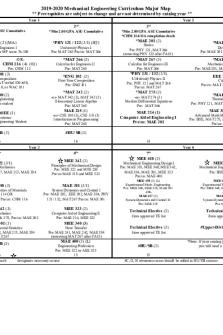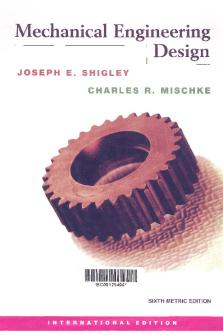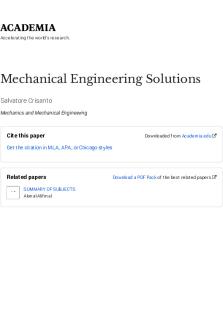Bio Mechanical Engineering - Prof. Roger D. Kamm PDF

| Title | Bio Mechanical Engineering - Prof. Roger D. Kamm |
|---|---|
| Course | Medical biology |
| Institution | Walter Sisulu University |
| Pages | 3 |
| File Size | 70.1 KB |
| File Type | |
| Total Downloads | 23 |
| Total Views | 141 |
Summary
Bio Mechanical Engineering - Prof. Roger D. Kamm...
Description
BE.010 Spring 2005 Session #5 notes
Bioengineering in Mechanical Engineering Outline of this session: - overview of the Mechanical Engineering (ME) major and its undergraduate requirements at MIT - discussion of the positions in industry available to Mechanical Engineers - a sampling of current research activities in the department - description of some of the biological engineering classes at MIT
Introduction Roger D. Kamm is a professor of Mechanical Engineering and Biological Engineering at MIT. His current research involves biomedical fluid dynamics and solid mechanics. Kamm describes most of his projects as “a blend of experiment, theory and numerical analysis.” (from MIT faculty website)
Overview of the ME Major The traditional ME curriculum (course 2) consists of the core required subjects, mostly taught by the ME faculty, two restricted electives, and four unrestricted electives, mostly taken during the student’s junior and senior years. The 2a program allows more flexibility within the program by substituting some of the required ME subjects with other classes. Students in course 2a can choose between Biotrack and the Energy Conversion Engineering track. Shown in this slide are the substitutes made for Biotrack. As you can see, organic chemistry, biochemistry, and biological engineering classes replace many of the second level ME classes. Some students in course 2 can easily minor in Biomedical Engineering since some of the medical engineering electives overlap with the ME restricted elective requirements. This spectrum shows the overlap between the school of engineering and the school of science, in this case representing mostly biology and chemistry. Finally, students majoring in the pure sciences such as biology are not much exposed to the school of engineering. The traditional ME major is founded on engineering. Course 2a brings the student in greater contact with biology and biological engineering. The proposed Biological Engineering (BE) major further acquaints the student with the life sciences.
Job Opportunities for Mechanical Engineers These two slides show the many ways students at MIT can be educated in bioengineering through choice of major and/or minor. The following slide shows industry opportunities for mechanical engineers with a biological engineering slant, such as 2a majors in Biotrack.
Research Groups at MIT
This slide lists the MIT faculty in the ME department and some of the research projects they are currently involved in. As you can see, mechanical engineers build useful devices on a wide scale range. So Lab: Cell Mechanics Associate Professor of Mechanical and Biological Engineering Peter So studies cell mechanics using rheological and spectroscopic tools. His lab deforms the flow of matter and alters beads on the cell surface in order to observe its Brownian fluctuations. The graphs on the right are expressed as functions of frequency. The So Lab is interested in understanding tissue physiology through the use of fluorescent photons that are made to penetrate the brain tissue. The resulting fluorescent vs. non- fluorescent cells can be used to create gene and protein expression profiles. Two-photon endoscopy, a method for examining the interior of the body, can be used to develop non-invasive optical biopsy. The latter would result in faster diagnosis and treatment, in addition to greatly reducing medical costs.
Ian Hunter: Bioinstrumentation using Nano-Technology Professor of Mechanical and Biological Engineering Ian Hunter is interested in the applications of nanotechnology to the life sciences. This slide compares the standard 96 well plate to a computer image of nano-cuvette arrays fabricated in his lab. Clearly, the latter's smaller size render it more efficient and portable. The private biotechnology company BioTrove was founded five years ago by students in the department of Mechanical Engineering at MIT who were inspired by Hunter's Bioinstrumentation Lab. In the past, Hunter worked on the development of drug delivery system devices that allow the skin to be permeable for a certain period of time. Hunter designed the NanoWalker, a robot device that walks on the surface of its surroundings to take measurements. This slide lists the functions that can be incorporated into the NanoWalker system. As you can see, highly orientated pyrolytic graphite is currently imaged with NanoWalker technology. This slide shows another fabrication of the Bioinstrumentation lab. BioTrove is currently devoted to the development of drug delivery system devices and other medical products through the use of nano-scale technologies. These pictures depict muscle tissue on different scales. Professor Hunter's lab made use of the charged and uncharged states of Calix[4]arene bis-bithiophene to induce conformational changes in the molecules, resulting in its expansion and contraction. The molecules were immersed in a bathing solution and attached to wires, allowing for the movement of the robotic hand.
Lang Lab: Single Molecule Biomechanics Assistant Professor of Mechanical and Biological Engineering Mathew J. Lang is interested in understanding the mechanical structure and function of proteins and enzymes in order to discover and develop biological motors. His lab makes use of facilities such as the ones shown in this slide. These instruments allow for single molecule fluorescence detection and optical trapping through the use of computers
to control position and beam paths. In this slide, a laser focuses down and traps a bead that has a different index of refraction from the surrounding fluid. The bead is linked to a protein to test the strength and power this particular biological motor. In this slide, an optical trap applies a known level of force to the trapped bead, which is attached to an actin filament. The Lang lab is interested in how different levels of force influence the degree of binding in proteins.
Griffith Lab: Tissue Engineering The Griffith Lab is interested in the development of a scaffold matrix to replace cancellous bone-bone with a spongy or Swiss cheese structure. Most of the elderly today with this ailment rely on grafting from another bone region to treat this ailment. This slide shows a microfabricated bioreactor that can test for toxicity in liver tissue. The growth factor protein (GFP) is used to tag and identify cells. The flow media exposes the toxin to liver cells. Fluorescent cells indicate the presence of toxin in solution.
Kamm Lab: Cellular and molecular biomechanics This slide shows the cellular force transmission pathways in the matrix of a cell. The layer between the intracellular and extracellular matrix is composed of many different types of protein. These proteins attract the cell membrane to its cytoskeleton. We will now focus on the particular set of proteins in the box. An external force is applied to the boxed area through the use of an electromagnet focused to the sharp tip. The tip is brought to a bead and a magnetic force is applied. We look at the response in the cell. In the picture in this slide, the light spots indicate the presence of protein in the cell. The graphs show the application of different levels of force and the resulting movement of the cell at different times and frequencies. This slide shows a specific example of a force-induced conformational change. Focal adhesion targeting (FAT) is a sub-domain of focal adhesion kinase (FAK). Shown is a molecular model of the domain of paxillin that binds to FAT. Using steered molecular dynamics (SMD), we apply a force to the molecular model and see how its conformation changes. This slide shows the stiffness properties of actin filaments in the cytoskeleton. The picture at the right shows a molecular model of an actin filament monomer. Granulues are small molecules found in neutrophils that later channel in the microfluidic device shown. The motion of the granulues is monitored. Brownian motion significantly decreases when the cell is immersed in a stiff matrix. The Kamm lab is interested in the systematic modeling of the cytoskeleton. They are constructing a computational model that mimicks the behavior of the cytoskeleton. If the cytoskeleton is deformed, it may rupture the actin filaments and the cross-linking proteins between the filaments....
Similar Free PDFs

Mechanical-engineering
- 1 Pages

Mechanical engineering
- 1 Pages

2019-2020 Mechanical Engineering
- 2 Pages

Mechanical Engineering Circuits
- 10 Pages

MECHANICAL ENGINEERING REVIEW MANUAL
- 509 Pages

Mechanical engineering lab report
- 18 Pages

Mechanical Engineering Lecture Notes
- 13 Pages

MECHANICAL ENGINEERING REVIEW MANUAL
- 509 Pages

Mechanical Engineering Elements
- 29 Pages

Mechanical engineering design
- 6 Pages

Mechanical Engineering Solutions
- 21 Pages

Mechanical Engineering Level M
- 16 Pages
Popular Institutions
- Tinajero National High School - Annex
- Politeknik Caltex Riau
- Yokohama City University
- SGT University
- University of Al-Qadisiyah
- Divine Word College of Vigan
- Techniek College Rotterdam
- Universidade de Santiago
- Universiti Teknologi MARA Cawangan Johor Kampus Pasir Gudang
- Poltekkes Kemenkes Yogyakarta
- Baguio City National High School
- Colegio san marcos
- preparatoria uno
- Centro de Bachillerato Tecnológico Industrial y de Servicios No. 107
- Dalian Maritime University
- Quang Trung Secondary School
- Colegio Tecnológico en Informática
- Corporación Regional de Educación Superior
- Grupo CEDVA
- Dar Al Uloom University
- Centro de Estudios Preuniversitarios de la Universidad Nacional de Ingeniería
- 上智大学
- Aakash International School, Nuna Majara
- San Felipe Neri Catholic School
- Kang Chiao International School - New Taipei City
- Misamis Occidental National High School
- Institución Educativa Escuela Normal Juan Ladrilleros
- Kolehiyo ng Pantukan
- Batanes State College
- Instituto Continental
- Sekolah Menengah Kejuruan Kesehatan Kaltara (Tarakan)
- Colegio de La Inmaculada Concepcion - Cebu



